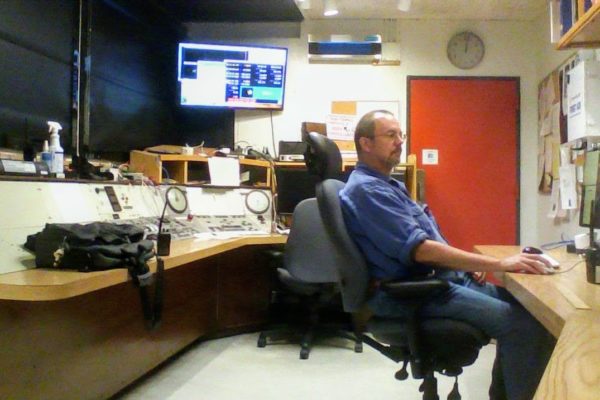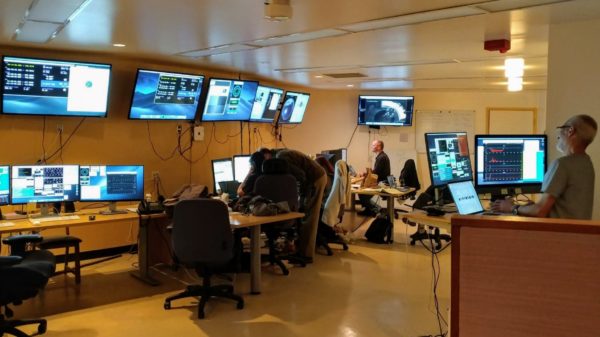David Lee Summers, Kitt Peak National Observatory
November 17, 2021
Many people who hear the word “astronomer” imagine a scientist spending long nights in an observatory dome peering through a telescope’s eyepiece. In fact, when the Nicholas U. Mayall telescope was commissioned in 1973, astronomers could sit at the telescope’s focus to operate the cameras. In those early days, the telescope operator worked at an analog console in a control room inside the dome. Over the years those telescope controls migrated to computers and the astronomers joined the telescope operators in the control room.

The control room is a cozy space. It’s a long, narrow room. The old analog console dominates one wall. Desks and shelves line the other walls. The closest restroom is two floors below the control room and the control room didn’t even have a sink until one was installed circa 2010. A small microwave allowed the operator and observers to heat their night lunches. When planning for the DESI survey began, people soon realized this space was far too small for the number of scientists who would need to collaborate on a given night while commissioning the instrument. Even during regular observing, it was expected that three or four people would need to be in the control room at the same time.
A new, larger space within the Mayall building was identified to serve as the control room. A former recreation room on the so-called Utility floor was renovated into a modern control room in 2017. Even before DESI operations began, we moved into the new control room to finish the Mosaic Z-band Legacy Survey. The new control room allowed several scientists to collaborate during the night. There was plenty of desk space for computers and monitors to watch all the telescope and DESI functions. An adjoining room held a small kitchenette and a meeting room. What’s more, restrooms were only one room further on. The U-floor control room seemed a vast improvement as a practical workspace—at least until the unexpected happened and operations had to be stopped in March 2020 for the COVID-19 pandemic.

Although we paused on-sky DESI commissioning, much thought was given to safe operations. Clearly we couldn’t have several people working together in one enclosed room, especially in the days before a vaccine had been developed and before the effectiveness of masks had been demonstrated.
Before the DESI installation began, some astronomers who used Kitt Peak facilities already observed remotely from their home institutions. They could log in and control an instrument through the internet and communicate with the telescope operator through video conferencing software. This idea became the core for new, safe DESI operations. The telescope operator would return to the old control room next to the telescope. A lead DESI observer would work in the new U-floor control room. All other collaborators would work either from home or their home institutions and communicate with the team at the telescope over Zoom.
As an operator who has worked at Kitt Peak since the 1990s, it’s been gratifying to watch DESI’s development and see this next step in the Mayall Telescope’s illustrious history. It’s also been gratifying to see how elements of the telescope’s legacy along with new technology have kept us operating through these challenging times.
